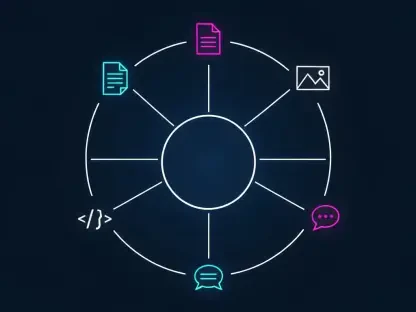In the ever-evolving world of technology, quantum computing stands as a beacon of potential and transformation. Despite its promise, this realm has been marred by significant challenges, especially concerning error correction and scalability. However, with the dawn of new breakthroughs, there is optimism that a new era in quantum networking is within reach. These advancements are not merely theoretical but hold significant promise in creating real-world applications that could forever alter computing paradigms.
The Promise of Quantum Networking
Bridging Past and Future
Quantum computing, which once seemed a distant dream, is now palpably closer to realization. Recent innovations by tech behemoths like Google, Amazon Web Services, and Microsoft mark this transition. These companies have been pivotal in addressing complex challenges like error correction, a crucial hurdle in quantum computing. Microsoft’s introduction of the Majorana processor stands out, hinting at a future where reliable quantum computing might be achievable within the near term. This technological leap, once viewed as decades away, now appears within the grasp of modern engineering, emphasizing a monumental shift from aspirational theories to tangible prototypes.
As quantum computing ventures closer to practical application, it’s not just mere aspirations driving this momentum but a substantial shift fueled by breakthroughs in processing and network architecture. These advances are reshaping the understanding of quantum mechanics in applied computing, promising systems that are not confined to theoretical constructs but are ready for integration in real-world scenarios. The speed at which these developments occur underscores the industry’s commitment to transcending traditional computational limits and reshaping the digital landscape.
A New Computing Paradigm
The concept of quantum networking is revolutionary, centered around connecting discrete quantum systems to unlock vast computational potential. This approach is akin to the historical evolution witnessed in classical computing, where interconnected systems overtook isolated machines. Quantum networking holds the power to transform this analogy into reality by creating systems that communicate seamlessly. The vision is to establish quantum data centers and global networks that act as the backbone of a burgeoning quantum internet. Such networks could fundamentally reshape industries, providing unprecedented computational capabilities across sectors including cryptography, drug discovery, and complex systems modeling.
The implications of this shift reach far beyond mere efficiency gains, promising to redefine how data is processed, transferred, and interpreted. Quantum networking offers a scope of connectivity unfathomable in classical terms, leveraging quantum entanglement to facilitate instantaneous data exchange between distant nodes. This could lead to unprecedented levels of security and computation speed, making the quantum internet a transformative component of future technological infrastructure. As groundbreaking as it sounds, the feasibility of this paradigm requires strategic architectural innovation and an unprecedented scale of global collaboration.
New Developments in Quantum Network Infrastructure
Cisco and Quantum Entanglement
Cisco Systems emerges as a pivotal force in the quantum networking landscape, poised to revolutionize how data is transmitted and processed. Through its collaboration with UC Santa Barbara, Cisco has unveiled a provisional quantum network entanglement chip. This innovation holds the potential to expedite the realization of impactful quantum applications, allowing for these systems to operate within existing technological frameworks. The chip’s capability to produce entangled photon pairs with high fidelity presents a groundbreaking advancement, marking a significant leap in integrating quantum mechanisms with classic data centers.
Such integration not only reinforces the viability of quantum technologies in current infrastructures but also hints at broader applications in computing and secure communications. The entanglement chip’s design ensures that it harmonizes seamlessly with today’s fiber networks, preparing the groundwork for future quantum networking solutions. The capability to maintain entanglement at room temperatures and low power consumption further underscores its practicality. As this technology matures, it promises to bridge the gap between quantum aspirations and operational reality, paving the way for the integration of quantum innovations into conventional systems.
Connected Technologies
To realize the vision of quantum networking, Cisco is pioneering an architecture that melds specialized hardware with innovative software. At the heart of this initiative is the adaptation of classical network devices to align with quantum mechanics’ unique requirements. The introduction of quantum-optimized switches and network interface controllers (NICs) epitomizes this effort. These devices are meticulously crafted to support quantum routing and the delicate task of entanglement distribution, ensuring their functionality does not disturb the quantum states critical to effective operation.
Central to Cisco’s vision is developing an infrastructure that supports quantum communications and enhances classical systems’ performance. This transition requires reimagining network designs where traditional nodes coexist with quantum-enhanced ones. The economic viability of these connected technologies lies in their ability to work seamlessly with existing networks while preparing them for a quantum future. By orchestrating such networks, Cisco aims to enact a paradigm where quantum and classical devices operate in synergy, thus expanding the horizons of computing beyond present limitations.
Comprehensive Quantum Networking Strategies
Inclusivity in Quantum Solutions
Cisco’s strategic approach to quantum networking emphasizes a vendor-agnostic framework, a philosophy that seeks to foster inclusivity and innovation across the quantum computing sector. Mimicking Nvidia’s facilitative role in the tech industry, Cisco endeavors to serve as an enabler of quantum technologies, rather than confining itself to a single technological avenue. This open strategy encourages diverse technological contributions, allowing for wider collaboration and rapid advancements within the field.
Such inclusivity ensures that a broad spectrum of quantum technologies can be utilized, fostering a richer innovation ecosystem. By not binding its development to one particular technological path, Cisco can adapt to breakthroughs as they happen, tailoring solutions to immediate needs and future trends. This flexible approach is anticipated to spur collaborative efforts across different technological sectors, thus catalyzing the maturation of quantum technologies into a mainstream computational solution. By driving quantum advancements through strategic partnerships, this ethos supports an inherent dynamic exchange of ideas and resources.
Building a Cohesive Quantum Environment
A cohesive quantum environment forms the bedrock of Cisco’s strategy to streamline the multifaceted elements of quantum networking. Focused on crafting a comprehensive development stack, Cisco’s efforts encompass protocols for entanglement distribution and the establishment of the Quantum Network Development Kit (QNDK). This toolkit facilitates the seamless integration of quantum components, essential in creating an interdependent network ecosystem capable of supporting sophisticated quantum communications.
At the heart of building such an environment is the alignment of quantum hardware with sophisticated software solutions, ensuring they function in unison. This synergy is pivotal to realizing a network capable of handling complex quantum operations effortlessly. By focusing on the holistic development of quantum networking components, Cisco lays the groundwork for environments where innovation can thrive, free from the fragmentation of incompatible technologies. The increasing convergence of enabling technologies fosters an ecosystem where quantum applications flourish, promising to redefine computational frameworks and ushering in a new era of technological harmony.
Industry Perspectives and Future Outlook
The Changing Landscape
The rapid evolution of quantum networking highlights a transformative period, moving it from a theoretical aspiration to a developing industrial reality. As major industry players continue to innovate and invest in this arena, the landscape of quantum networking is set to change profoundly. The collaborative efforts across various sectors have fostered an environment where theoretical constructs are quickly evolving into practical solutions, making quantum networking a vital component of future computing strategies. Given the strides made by titans like Cisco, Google, and Microsoft, the vision of a fully operational quantum network seems increasingly plausible.
With its potential to impact industries like finance, healthcare, and cybersecurity, quantum networking is expected to create new computing paradigms. By offering capabilities unattainable by classical computing, such as exponentially faster data processing and unprecedented security measures, quantum technologies could redefine the boundaries of what is possible. The competitive and collaborative efforts by industry leaders underscore a collective momentum towards making quantum networking not just a possibility but a near-term reality.
Towards Collaborative Innovation
In the swiftly advancing realm of technology, quantum computing emerges as a symbol of potential and transformative progress. Quantum computing has the potential to revolutionize many industries by solving complex problems that classical computers cannot. Nevertheless, its journey has not been without hurdles, primarily focused on error correction and scalability challenges. For quantum computers to be a staple in everyday applications, errors must be minimized, and systems scaled effectively. Despite these obstacles, recent breakthroughs have ignited hope for a forthcoming era in quantum networking. These advancements suggest not just theoretical enhancements but tangible real-world applications that promise to revolutionize computing philosophies. From optimizing complex system operations to unlocking unprecedented computing power, quantum computing stands poised to redefine our technological horizon, creating opportunities to enhance a myriad of fields, from medicine to cryptography, and ushering in a new paradigm that could permanently alter how we perceive computing capabilities.









